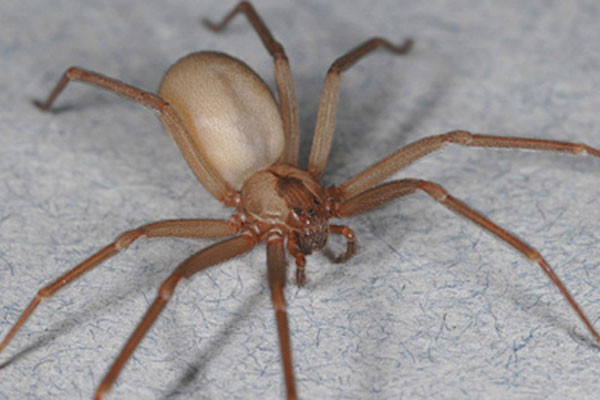Types of Spiders & Spider Facts

All spiders are predatory eight-legged creatures that have organs to spin silk at the back ends of their bodies. They are the largest part of the Arachnid family, a group that also includes scorpions and ticks. Spiders all have the ability to bite with venom-injecting fangs to kill prey and nearly all of them are poisonous (even if it's just a little).
There are about 40,000 types of spiders in the world, living on every continent except Antarctica. And they're not newbies: fossilized spiders have been found in Carboniferous rocks dating back 318 million years.
Spider anatomy
Spiders have two body segments, the abdomen and the cephalothorax. The first, or front part, is the cephalothorax, which is formed by the fusing of the head and thorax, according to Jo-Anne Nina Sewlal, an arachnologist at the University of the West Indies in Trinidad. The cephalothorax contains the eyes, mouth and legs.
The mouth has several parts. The spider's jaws, called the chelicerae, are tipped with fangs, according to entomologists at the University of Kentucky. These appendages are used to hold prey while the spider injects venom. Behind the jaws are the labium and labrum, which work together to direct food into the spider's mouth.
Between the chelicerae and the first pair of legs are the pedipalps, which look like tiny legs but are actually similar to antennae, and are used to sense objects the spider encounters, Sewlal said. However, "they are used by some species in prey capture and feeding as well as in shaping their webs."
Pedipalps are also used in mating and are a good way to tell males and females apart. "The tips in males are enlarged as they are used to transfer sperm to the female, while in the female, the tips of the pedipalps remain undifferentiated," Sewlal said.
Most spiders have six or eight eyes, according to the University of Kentucky. Some spiders can only see the difference between light and shadow. Their eyes are considered "simple," as they don't have compound lenses as some insects do.
Get the world’s most fascinating discoveries delivered straight to your inbox.
A spider's abdomen is where most of its important internal organs are located, such as the reproductive system, lungs and digestive tract. Also on the abdomen are the spinnerets, through which a spider produces its silken web.
Spider webs
Spider silk is made of strong strands of protein. It is the strongest-known natural fiber, according to the San Diego Zoo. Its tensile strength — the greatest stress a material will tolerate before breaking — is greater than bone and half the strength of steel.
According to the Smithsonian Museum of Natural History, individual species can produce up to seven distinct types of silk, each with a specialized function. Some spiders use their webs to trap prey; others line their burrows with it.
Spiders are grouped according to the type of web they make, according to the San Diego Zoo. Groups include tangle-web spiders, orb-web spiders, funnel-web spiders and nursery-web spiders.
According to the Australian Museum, spiders capture prey using a variety of methods. They can trap small insects in sticky webs, lasso them with sticky bolas, or use their vibration-sensing skills to chase prey down. Spider guts are too narrow to take solids, so they liquidize their food by flooding it with digestive enzymes and grinding it up with short appendages.
Spider bites
Even though all spiders can bite, most of them do no more harm to a human than a bee sting or a mosquito bite. Most spiders with a life-threatening bite are quite shy and attack only when they feel threatened. According to Spider Physiology and Behaviour, Volume 41 (Advances in Insect Physiology), there were only about 100 deaths from spider bites during the 20th century.
According to Sewlal, spider venoms work on one of two fundamental principles: they either attack the nervous system with neurotoxic venom, or attack tissues around the bite with necrotic venom. Sewlal explained that neurotoxic venom works in two ways: by overstimulating "the production of the neurotransmitters ... which can cause the entire nervous system to become paralyzed," and by blocking "nerve impulses to the muscles. This has the result of causing the muscles to cramp and become rigid. It also has the effect of disrupting many bodily functions." Necrotic venom works by causing "the tissue around the bite to die."
Researchers are investigating novel uses for spider venom, from an eco-friendly (and bee-friendly) alternative to pesticides, to treatments for Alzheimer’s disease, cardiac arrhythmia and strokes. In addition, spider silk has lots of engineering uses, from body armor to optical communications.
Arachnophobia
Humans have long had a tumultuous relationship with the eight-legged critters. Arachnophobia, or fear of spiders, is one of the most common phobias. Some statistics show that 50 percent of women and 16 percent of men have this phobia, according to The Wall Street Journal.
According to Mentally Healthy, evolutionary biologists surmise that a modern fear of spiders may be an exaggerated form of an instinctive response that helped early humans to survive. Other scholars think that fear of spiders began in the Middle Ages, when spiders became a cultural scapegoat for inexplicable epidemics of the time, like the plague.
Classification/taxonomy
According to the Integrated Taxonomic Information System (ITIS), the taxonomy of spiders is:

- Kingdom: Animalia
- Subkingdom: Bilateria
- Infrakingdom: Protostomia
- Superphylum: Ecdysozoa
- Phylum: Arthropoda
- Subphylum: Chelicerata
- Class: Arachnida
- Order: Araneae
Suborders
According to Sewlal, spiders can be divided into two suborders: Mesotelae and Opisthothelae, which contains the infraorders Mygalomorphae and Araneomorphae.
Mesothelae: "The suborder Mesothelae contains only one family, Liphistiidae," Sewlal said. "The members of this family are quite distinctive from all other spiders." She explained that the Mesothelae suborder is so named because its members have their spinnerets located on the middle of the abdomen, on their underside. According to the Australian Museum, these are "primitive spiders"; "modern" spiders have spinnerets toward the back of their abdomens. They also have abdomens segmented similarly to scorpions, Sewlal said.
These small, light spiders reside in Southeast Asia, China and Japan. Though scientists previously thought they lacked venom glands, new research has shown that they do have them.
Opisthothelae: These spiders have spinnerets at the posterior of their abdomens, Sewlal said. She offered some advice on how to distinguish between the infraorders Mygalomorphae and Araneomorphae: Look at the position of the chelicerae. "Araneomorphs have chelicerae where the tips crisscross each other, while mygalomorphs have chelicerae that point downwards like that of the typical vampire and move in the vertical plane." Their book lungs — respiratory organs so named because their thin membranes resemble pages in a book — are also different. "Mygalomorph spiders also have two pairs of book lungs while araneomorph spiders have one pair of book lungs or no book lungs at all."
Here are some other features of the two infraorders.
Mygalomorphae: According to Arachne.org, these spiders are generally heavily built and hairy, like tarantulas. They live in burrows, and can prey on creatures as large as frogs, lizards and snails. A few species build webs, but it is not very common. Although most spiders live for at most two years, many mygalomorphae spiders can live up to 25 years in captivity. This type of spider includes the huge goliath birdeater, which can grow up to 1 foot in body length, according to the Conservation Institute.
Araneomorphae: These are the most common of spiders, making up more than 90 percent of all the species, according to Biology of Spiders. Some of the most interesting species include the only known vegetarian spider, the Bagheera kiplingi, as well as the most venomous spider, the Brazilian wandering spider. Scientists have found that the spider needs to inject only 6 micrograms of its venom to kill a 20-gram (0.7 ounces) mouse, and a full venom load is more than 10 times that.
Katherine Gammon contributed to this article.
Editor’s Note: If you’d like more information on this topic, we recommend the following book:
Additional resources
- Learn more about Jo-Anne Nina Sewlal's research into orb-weaving spiders.
- Explore the Australian Museum's collection of spiders and other arachnids.
- Find more fun facts about spiders at the San Diego Zoo.
Learn facts about these popular spiders:
Jessie Szalay is a contributing writer to FSR Magazine. Prior to writing for Live Science, she was an editor at Living Social. She holds an MFA in nonfiction writing from George Mason University and a bachelor's degree in sociology from Kenyon College.
